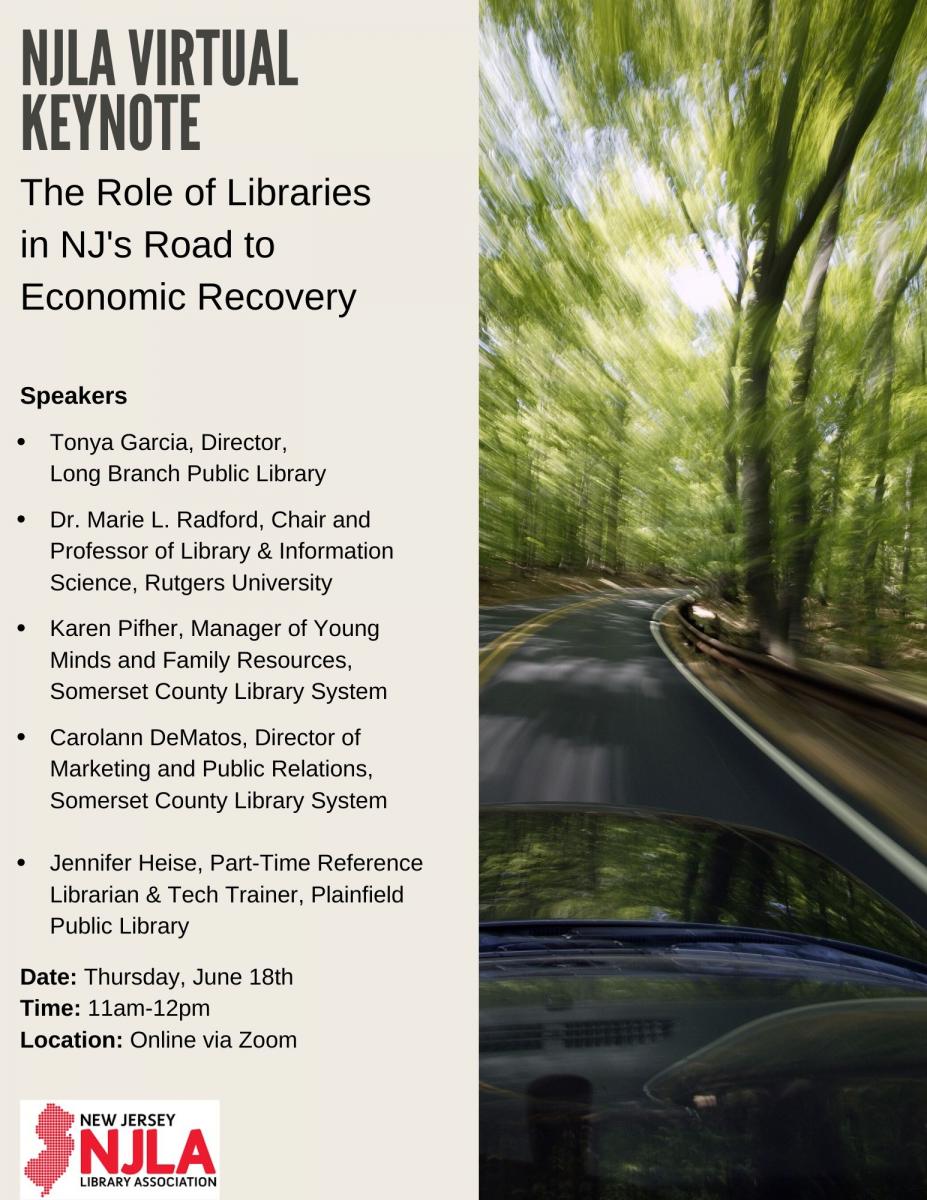NJLA Professional Development Newsletter - Spring 2020
 Welcome Message
The current COVID-19 pandemic further emphasizes the value of remote professional development opportunities. We discovered this on Friday, March 13th when, despite school and library closures, we were still able to offer our NJLA Virtual Keynote, The Virtual Library is Open: Serving Your Community During the COVID-19 Pandemic. Webinars and online meetings allow us to feel more connected to colleagues while adjusting to working from home -- particularly when they are with familiar faces from New Jersey libraries. Hearing about, and viewing, the excellent remote programming and services that libraries have implemented make me appreciative and proud to be part of this profession. On Friday, May 15, we offered our NJLA Virtual Keynote, Reopening Libraries Amid the COVID-19 Pandemic. While we didn't reach the thousands that DJ D-Nice has attracted during his Club Quarantine Instagram dance parties, we did have 800 registrants and 530 attendees during the presentation, which confirmed that desire that we have for connection with fellow library employees. Here is some of the feedback we received: "The highest value of the Webinar was seeing what was on the mind of others and sharing common concerns." "We're all in this together when it comes to this pandemic and wanting to reopen our libraries safely." "It was good to find common ground in an isolated environment. It means that we are not alone. That was a MOST important concept to pass along." "I think it helped get everyone on the same page, and think about questions they may not have considered until now. It felt unifying." Here are the recordings for the NJLA Virtual Keynotes that the NJLA Professional Development Committee has produced during this past year:
For further remote professional development opportunities, please check out the free podcast and webinar resources at the end of this newsletter. And many thanks to James Gross, Cataloging Librarian at the West Deptford Free Public Library, for your contributions to this growing list. Sincerely, Theresa
|
|
|
|
|
|
VALE Conference RecapCara Berg, President, NJLA College & University Section/The New Jersey Chapter of the Association of College & Research Libraries The VALE Conference looked very different this year. Traditionally, VALE is held at Rutgers University in the Busch Conference Center and completely on its own. This year, VALE was co-located with EDGECon and was moved to the beautiful Ocean Place Conference Center in Long Branch. Sessions at VALE included traditional presentations, a networking session, lightning talks, and round tables for a full and wide-ranging conference experience. With the theme of Inclusive Libraries: Connecting Users in the Digital Age, attendees were able to view top-quality presentations and experience stunning ocean views, even in January. The keynote, Jason Schmidt, talked about academic publishing and paywalls and was very well received. It was truly wonderful to work with a group of such talented librarians to plan this conference and I’m thrilled to have been a part of that team. The conference would not have been what it was without the work of so many people. I look forward to our next VALE Conference together! VALE Conference Photos NJLA Youth Services ForumThe Youth Services Forum in October 2019 was held at the Monroe Township Public Library, and included lively presentations by youth services librarians and authors Leeza Hernandez and Wil Mara. There were several presentations that targeted teen librarians, starting with "Welcoming Teens to the Library," which included best practices for addressing how all library staff interact with teens in the building based on research about teen brain development and behaviors. Akiema Buchanan (Paterson), Jenna Ingham (East Brunswick) and Stacey Shapiro (Cranford) presented "We Have Diverse Books, Now What?," which was a lively discussion on how to serve your community by going beyond ordering diverse titles for your collection. Tips included how to talk to your teens about diversity, book displays, and programs with community organizations that celebrate holidays of cultural significance. Hannah Lee (Sayreville) presented "Chapter Quest Role Playing Game," which provided step-by-step instructions for leading your own fairytale, myth, or folk-tale based role play game at your library. The "Lending Nontraditional Items @ Your Library" panel was a "petting zoo" type presentation by librarians from Cape May County, Cherry Hill, East Brunswick, Livingston, and Sparta. Highlights included a popcorn machine, American Girl Dolls, sewing machines, and knitting looms. Top of Page | Table of Contents
|
 Theresa Agostinelli
Theresa Agostinelli



 Marie L. Radford
Marie L. Radford
 Erica Krivopal
Erica Krivopal
 Kerry Weinstein, NJLA Member at Large
Kerry Weinstein, NJLA Member at Large
 Doug Baldwin, Head of Technology,
Doug Baldwin, Head of Technology,


 by Theresa Agostinelli
by Theresa Agostinelli
 Linda Hoffman, Director of the Alfred
Linda Hoffman, Director of the Alfred
 While it might seem like a long time ago, the 2020 VALE/ACRL-NJ/NJLA CUS User’s Conference was just this January. It was one of the last times this year a large group of New Jersey librarians were able to gather together, and looking back on it, I am grateful we had that opportunity!
While it might seem like a long time ago, the 2020 VALE/ACRL-NJ/NJLA CUS User’s Conference was just this January. It was one of the last times this year a large group of New Jersey librarians were able to gather together, and looking back on it, I am grateful we had that opportunity!


